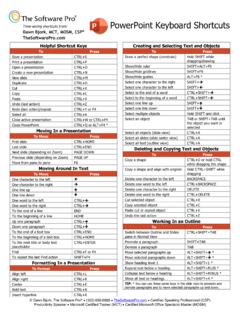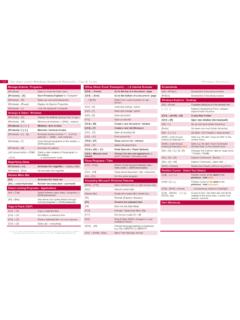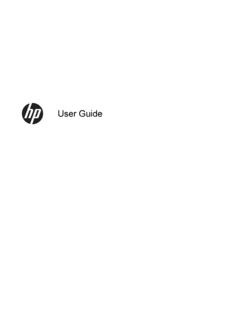Transcription of Access and Accessibility in Online Learning
1 OLC RESEARCH CENTER FOR DIGITAL Learning & LEADERSHIP Access and Accessibility in Online Learning Issues in Higher Education and K-12 Contexts From OLC Outlook: An Environmental Scan of the Digital Learning Landscape June 2018 Katherine McAlvage, Marlyhurst College Mary Rice, University of New Mexico OLC Research Center for Digital Learning & Leadership 1 Introduction Accessibility in K-12 and higher education is becoming an increasingly complex terrain to traverse as schools increase Online materials and instructional delivery options. This white paper provides an overview of critical terms, legal precedents, and other considerations for course designers, instructors, and administrators as they work to improve the educational experiences of learners with disabilities.
2 Key questions around Accessibility include the following: 1. How do national laws that govern disability Access apply to Online courses? 2. What case law exists to guide Online course design and delivery in various educational settings? 3. What issues emerge regarding Online course Access that might be unique to higher education and to K-12 settings? What issues are shared? 4. What support do Online course designers need in order to generate accessible courses for learners across the life span (from K-12 to higher education)? The first section of this white paper provides definitions for concepts related to Accessibility in digital educational environments. Second, Accessibility in Online course design from both practical and policy perspectives are elaborated for both higher education and K-12 education.
3 Helpful references and resources -- including active Online communities of practice -- are provided at the end of the document. OLC Research Center for Digital Learning & Leadership 2 Definitions Accessible Technology: Accessible technology includes a broad range of constantly changing tools and features that support the Learning of students with disabilities. Common examples include: Screen readers: applications that read digital text to users, provided that the document being read is tagged appropriately and is readable by this application. Use case: a visually impaired student uses a screen reader to read a PDF document aloud. A student can also use the application to navigate around sections of the document by using keyboard shortcuts.
4 Alt text: attributes attached to images that provide brief descriptions of images, tables, and other graphics. Use Case: a low-vision student uses a screen reader for an HTML web page and the image s alt text field is read aloud as a way to learn what is in the image. Captions: scrolling text available on the bottom edge of a video frame that accurately capture diegetic (natural what is happening on screen) and non-diegetic (off the screen, inorganic) auditory dimensions of the video, including silences, descriptions of dialect when necessary, and descriptions of music. Use Case: a deaf or hearing-impaired student uses captions to read a professor s lecture in a recorded video.
5 ADA and ADAAA: The Americans with Disabilities Act (ADA) is a civil rights law that prohibits discrimination against individuals with disabilities in all areas of public life, including OLC Research Center for Digital Learning & Leadership 3 jobs, schools, transportation, and all areas of public and private areas that are open to the general public (ADA National Network, ). Any institution receiving federal funding must comply to ADA requirements. The ADA was signed into law in 1990; in 2008, the American Disabilities Act Amendments Act (ADAAA) clarified the definition of disability ( Equal Employment Opportunity Commission, ). Students in both higher education settings and K-12 settings are protected by this law.
6 Section 508 of the Rehabilitation Act of 1973: Section 508 mandates that all electronic and information technology used by the federal government be accessible to people with disabilities. However, broader interpretations of this law have occurred over time such that colleges and universities that receive any form of federal funding must also meet minimum standards for Accessibility outlined by Section 508 as well (LaGrow, 2017). Section 508 requirements are often compared to the Web Content Accessibility Guidelines , or WCAG , which outline three levels of compliance: Level A, which is the minimum; Level AA, which is often used by institutions worldwide as their internally mandated minimum and includes conformance to Level A requirements; and Level AAA, which is the highest level and includes conformance to Level A and Level AA requirements (Essential Accessibility , 2017; W3C Working Group, 2018).
7 Students in both higher education settings and K-12 settings are protected by this law. Section 504 of the Rehabilitation Act of 1973: Section 504 protects students with disabilities against discrimination in all educational programs that receive funding from the Department OLC Research Center for Digital Learning & Leadership 4 of Education. It states: No otherwise qualified individual with a disability in the United shall, solely by reason of her or his disability, be excluded from the participation in, be denied the benefits of, or be subjected to discrimination under any program or activity receiving Federal financial " ( Department of Education Office of Civil Rights, ).
8 Section 504 is enforced by the Office of Civil Rights, which is a unit of the Department of Education. Students in both higher education settings and K-12 settings are protected by this law. Title II: Title II focuses on protecting individuals with disabilities against discrimination in services, programs, and activities that are provided by state or local government, including public schools. This measure extends the prohibition on discrimination established by Section 504 of the Rehabilitation Act of to all activities of State and local governments regardless of whether these entities receive financial assistance (United States Department of Justice Civil Rights Division, ).
9 Title II is also enforced by the Office of Civil Rights within the Department of Education. Students in both higher education settings and K-12 settings are protected by this law. IDEA: The Individuals with Disabilities Education Act (IDEA, 2004) provides free and public K-12 education (FAPE) to students with disabilities and supports special education services in the least restrictive environment (LRE) possible. State and public agencies are responsible for administering IDEA within certain guidelines, and for disbursing funding for special education programs ( Department of Education, ). There are six core principles in IDEA: FAPE, LRE, non-discriminatory evaluation, zero-reject, due process, and parent and student OLC Research Center for Digital Learning & Leadership 5 participation (see Basham, Stahl, Ortiz, Rice & Smith, 2015 for an elaboration on these for Online Learning ).
10 The Office of Special Education and Rehabilitative Services, a unit of the Department of Education, oversees IDEA. This law only applies to students ages 3 to 21 who are enrolled in K-12 public schools. It does not apply to higher education. Selected Case Law and Civil Complaints about Accessibility Louisiana Tech University: A visually impaired student at Louisiana Tech sued the university and its board in 2013 for discrimination under Title II of ADA. The student enrolled in a course with inaccessible Online materials that were not remediated until more than a month into the quarter. The settlement terms included remediation of content, a more comprehensive Accessibility policy, and training for instructors and administrators on ADA requirements (Department of Justice Office of Public Affairs, 2013).



















